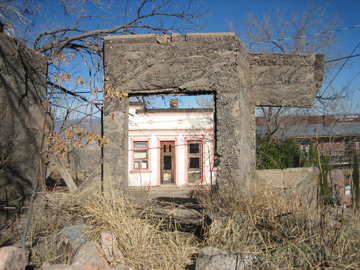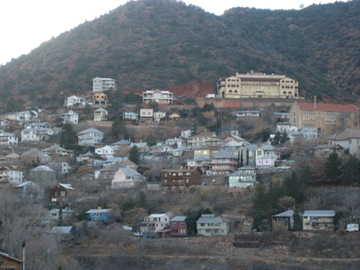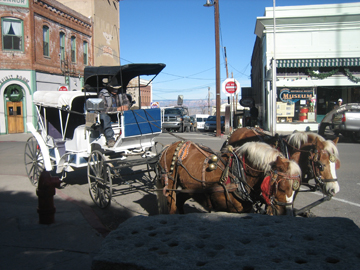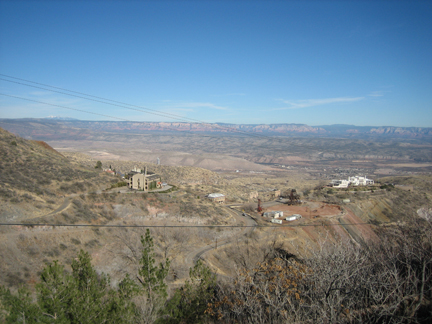|
Travels in Geology January 2007, posted January 17, 2007
Jerome: A ghost town
that never gave up the ghost
Michael Price
 |
|
Once
a booming mining city of 15,000, Jerome, Ariz., now boasts a population
of 350 people, many of whom are artists. All photos by Michael Price.
|
Drinking early morning coffee, talking with good friends,
and walking the streets of rough-cut stone
she once was a miner's city, now the ghost of a dying town, but there's
a fire burning bright in Old Jerome
-folksinger Kate Wolf
Scattered along the tangled webs of Arizona's smaller highways
and nominally-maintained county roads — far from the well-traveled
interstates bustling hurried motorists between Phoenix and Los Angeles
— hundreds of crumbling facades and bare foundations mournfully greet
passersby. These silent sentinels of the desert are abandoned relics from
a mining boom in the Southwest that exploded in the mid-1800s and trickled
to a halt as the century turned. Once thriving meccas for miners, prospectors,
prostitutes and pioneers, they have become ghost towns.
Jerome, a charming burg perched vertically along the side of Cleopatra
Hill in the North Central part of the state, almost shared their fate.
The New York Sun declared Jerome "the wickedest town in the
West" in 1903, citing its abundance of saloons and brothels. At its
heyday, Jerome's population was around 15,000, making it the fifth largest
city in Arizona. By the late 1950s, that number had plummeted to about
50 residents. It looked like the town was well on its way to abandonment.
But then a curious thing happened: while its boomtown cousins settled
peacefully into their graves, Jerome was resurrected.
 |
|
Jerome is
precariously perched on a mountainside about 175 kilometers from
Phoenix. The Jerome Grand Hotel, once a hospital
and now the site of an award-winning restaurant, can be seen in
the distance.
|
Today, the town — population 350 — is a respected artists' community where the ghosts of those who settled the West mingle with the pioneering spirits of new residents. Jerome's mining past has laid bare much of the area's interesting geology, with pared-off mountainsides revealing sedimentary layers stretching back into the Precambrian. And yet there is a distinctly fresh feel to the town; residents respect the past but have added their own modern pages to its history.
The two different routes into Jerome reflect the dichotomy between old and new. You can take highway 89-A east from Prescott — a popular, arboreous destination with its own frontier history located about 160 kilometers north of Phoenix and 600 kilometers east of Los Angeles — where the road winds high up into Mingus Mountain and whips you around seemingly endless hairpin turns. Because the road is carved out of the mountainside, the mountain's stratigraphy is fully on display as you zip around the curves. But be careful: sometimes just going the speed limit can be challenging, lest a careless turn leave you dangling precariously over a ridge. But those hardy enough to tackle this route are rewarded with stunning tours of pine-covered valleys and views of the jagged horizon carving across the big Arizona sky. The flushed, layered sandstone of Sedona's Red Rocks are visible in the distance. One final corner around a mountain pass leads you straight into Jerome.
If you would rather forego some scenery for a smoother ride, modernity has manifested in the form of Interstate-17, which runs between Phoenix and Flagstaff. The interstate meets up with highway 89-A/260 and winds through Cottonwood into Jerome. This drive shaves about an hour off of the driving time from Prescott, so it's a good alternative for quick trips.
 |
| Jerome looks like a throwback to the old days of the Wild West, but offers modern amenities such as nice restaurants, art galleries and museums showcasing the region's mining history. |
One of the first things you'll notice about Jerome is that it is horizontally challenged. It clings to the side of Cleopatra Hill, with streets zigzagging down the mountainside. The effect is a terraced checkerboard of renovated buildings sandwiched between crumbling buildings. It's an image that wouldn't feel entirely out of place in a Dr. Seuss book.
The long, winding drive will leave you hungry, so it's a good thing Jerome denizens make food a priority. Dozens of locally owned cafes and restaurants dot the sidewalks, offering travelers an impressive variety of eateries for such a small town. You'll have your choice of delicatessens, pizzerias, steakhouses, burger joints and even a AAA Three Diamond and Wine Spectator award-winning restaurant called the Asylum (located in the Jerome Grand Hotel, which was originally erected in 1926 as the town hospital). Many artists call Jerome home, and as a result, a number of galleries showcase their unique work. An "artwalk" takes place on the first Saturday of each month when 30 galleries open their doors to art aficionados.
Still, Jerome's mining roots shine through its boutique-lined streets. A handful of mining museums will entice history wonks, and rusted-out mining equipment and the open pit's black, stepped mountainside are ever-present reminders of the past. Jerome made a name for itself as a copper hotbed — the result of two giant, mineral-rich hydrothermal vents that formed its ore deposits some 1.7 billion years ago. Over the years, 600 million pounds of copper, 800 tons of silver and 28 tons of gold were mined in Jerome before operation costs outstripped production and the mines finally shut down completely in 1953.
 |
| Visitors can still see vestiges of the old Jerome, such as several mines. Jerome's claim to fame came from an underground inferno that burned for 30 years before it finally went out. Techniques to fight the fire, however, such as injecting water, carbon dioxide and steam into the burning areas, managed to leave six entirely new minerals in the mine, and one controversial "mineral," jeromite. |
Jerome may be best known for its lucrative mining production, but its geological claim to fame actually resulted from a production nightmare. In 1894, a fire broke out in the United Verde mine that borders the town. Probably caused by spontaneous combustion when the unstable sulfide minerals encountered air, the fire thrived in the mineral-rich environment. As the underground inferno feasted on the richest part of the mine, workers threw every firefighting technique they knew at the fire. They tried sealing off the fire to deprive it of oxygen, but the porous rocks allowed the blaze to burn on. Next, they injected water, carbon dioxide and steam into the burning areas, but those measures failed as well. Finally, the United Verde Mining Company admitted defeat and switched to open-pit mining. The fire eventually burned itself out 30 years later.
But packing steam and carbon dioxide into the mine had created a highly pressurized, gaseous, mineral-rich environment. When local geologists took samples of strange minerals that had collected around natural vents in the area, they noticed something unusual. The minerals could not have formed from known gases in the mine, so geologists concluded that the steam and water injected into the mine caused a secondary suite of rare minerals to form. After further examination, a total of six entirely new minerals were identified — butlerite, ransomite, guildite, laurenite, yavapaiite and claudetite — as well as samples of very rare elemental selenium. A seventh mineral, jeromite, was also discovered, but its status as a true mineral is controversial. It is unclear whether jeromite could have arisen without human influence, and because no original samples are available for study, the International Mineralogical Association lists its status as "Questionable/Doubtful."
Today, the United Verde Copper Mine has been all but swallowed up by open-pit mining, but a kilometer north resides Gold King Mine (you'll see signs with directions as soon as you enter town), an abandoned mine-cum-tourist attraction that mixes history with local lore to form a kind of whimsical museum. For a small fee, you can peruse the well-preserved remains of the settlement that grew up around the mine, sprinkled with machinery and mining paraphernalia. The mine itself is long closed, but you can visit a replica mine shaft to get a good idea of what conditions were like.
Like its mineral namesake, Jerome exists in a questionable state: not
quite a ghost town, but not quite a normal town, either. Perched on the
side of a mountain like a cornered fighter, it continues to win its fight
against the odds: a town that refuses to let history forget it.
Price is a graduate student in the Johns Hopkins University Science Writing program. He has a degree in journalism from Arizona State University. He wishes to thank Nora Graf with the National Park Service for information on Jerome history.
Links:
Jerome
Chamber of Commerce
Jerome
Grand Hotel
Jerome
Times history
Jeromite
Mineral Information
"Red Rock Country,"
Geotimes online, Travels in Geology, March 2004

 Subscribe
Subscribe


